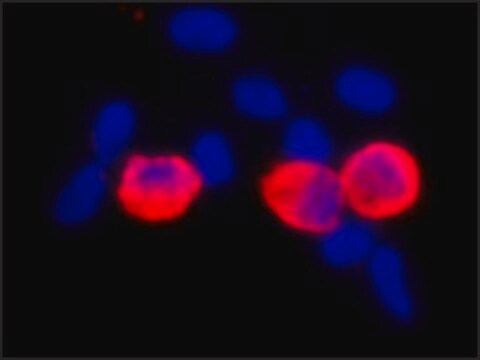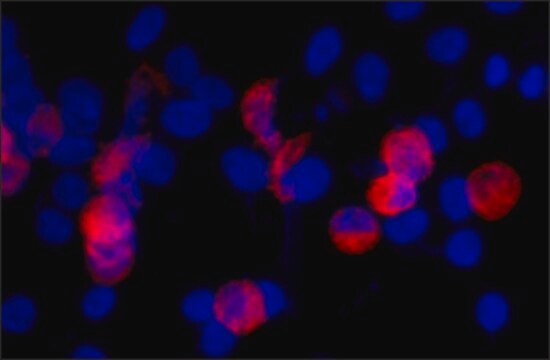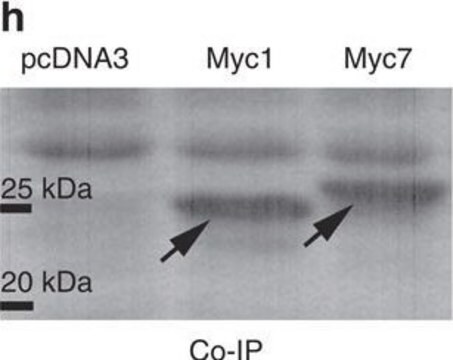추천 제품
생물학적 소스
mouse
Quality Level
결합
CY3 conjugate
항체 형태
purified immunoglobulin
항체 생산 유형
primary antibodies
클론
9E10, monoclonal
양식
buffered aqueous solution
종 반응성
human
기술
direct immunofluorescence: 1:50 using formalin-fixed, paraffin-embedded human colon carcinoma tissue
UniProt 수납 번호
배송 상태
wet ice
저장 온도
2-8°C
타겟 번역 후 변형
unmodified
유전자 정보
human ... MYC(4609)
유사한 제품을 찾으십니까? 방문 제품 비교 안내
일반 설명
Monoclonal Anti-c-myc (mouse IgG1 isotype) is derived from the 9E10 hybridoma produced by the fusion of mouse myeloma cells and splenocytes from an immunized BALB/c mouse. The c-Myc gene encodes a polypeptide with a predicted molecular weight of 49 kDa.
면역원
synthetic peptide of the human p62c-Myc protein.
애플리케이션
Monoclonal Anti-c-MycCy3™ antibody produced in mouse has been used in:
- western blotting
- immunocytochemistry
- Immunofluorescence
생화학적/생리학적 작용
The encoded protein is involved in cell proliferation, growth and apoptosis. The c-myc gene has been implicated in the development of a number of neoplasms in a variety of avian and mammalian species. The human c-myc protooncogene is the cellular homolog of the avian v-myc gene found in several leukemogenic retroviruses. Increased expression of the cellular oncogene c-myc has been described in a variety of human tumors, occurring by several different mechanisms, including gene amplification and chromosomal translocation.
물리적 형태
Solution in 0.01 M sodium phosphate buffered saline containing 1% bovine serum albumin and 15 mM sodium azide.
법적 정보
Cy3 is a trademark of Cytiva
면책조항
Unless otherwise stated in our catalog or other company documentation accompanying the product(s), our products are intended for research use only and are not to be used for any other purpose, which includes but is not limited to, unauthorized commercial uses, in vitro diagnostic uses, ex vivo or in vivo therapeutic uses or any type of consumption or application to humans or animals.
적합한 제품을 찾을 수 없으신가요?
당사의 제품 선택기 도구.을(를) 시도해 보세요.
Storage Class Code
10 - Combustible liquids
WGK
nwg
Flash Point (°F)
Not applicable
Flash Point (°C)
Not applicable
개인 보호 장비
Eyeshields, Gloves, multi-purpose combination respirator cartridge (US)
Nir London et al.
Biochemistry, 51(29), 5841-5850 (2012-06-19)
Interactions between Bcl-2-like proteins and BH3 domains play a key role in the regulation of apoptosis. Despite the overall structural similarity of their interaction with helical BH3 domains, Bcl-2-like proteins exhibit an intricate spectrum of binding specificities whose underlying basis
Sanjib Dutta et al.
Journal of molecular biology, 398(5), 747-762 (2010-04-07)
Interactions among Bcl-2 family proteins are important for regulating apoptosis. Prosurvival members of the family interact with proapoptotic BH3 (Bcl-2-homology-3)-only members, inhibiting execution of cell death through the mitochondrial pathway. Structurally, this interaction is mediated by binding of the alpha-helical
A highly secreted sulphamidase engineered to cross the blood-brain barrier corrects brain lesions of mice with mucopolysaccharidoses type IIIA
Sorrentino NC, et al.
EMBO Molecular Medicine, 5(5), 675-690 (2013)
Marie Pierron et al.
The Journal of neuroscience : the official journal of the Society for Neuroscience, 36(24), 6525-6537 (2016-06-17)
Diffuse extrasynaptic neurotransmitter receptors constitute an abundant pool of receptors that can be recruited to modulate synaptic strength. Whether the diffuse distribution of receptors in extrasynaptic membranes is a default state or is actively controlled remains essentially unknown. Here we
Human MAMLD1 gene variations seem not sufficient to explain a 46, XY DSD phenotype
Camats N, et al.
PLoS ONE, 10(11), e0142831-e0142831 (2015)
자사의 과학자팀은 생명 과학, 재료 과학, 화학 합성, 크로마토그래피, 분석 및 기타 많은 영역을 포함한 모든 과학 분야에 경험이 있습니다..
고객지원팀으로 연락바랍니다.







